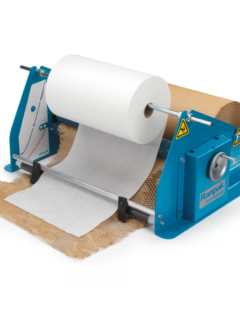FFP class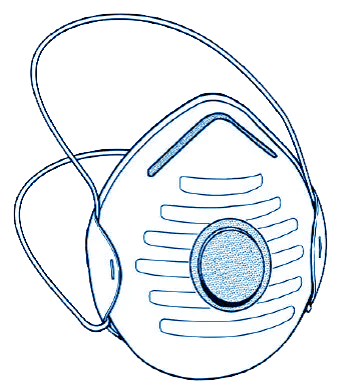 |
Filter level |
Uses |
| FFP1 | ► Protect against harmless smoke/dust/fog. ► Filter capacity 78% E.g. Cotton or wood particles, graphite, ferrous metals, calcium carbonate, hay, etc. |
Construction sector, food industry. |
| FFP2 | ► Protects against irritating smoke/dust/mist. ► Filter capacity 92% E.g.: Residual metal particles, resin and glass wool, seeds and fungi, flour dust, etc. |
► Protects against smoke/dust/smog. ► Filter capacity: E.g.: Ceramic fibres, ceramic fibres, ceramic fibres, dust, etc 98% For example: Ceramic fibres, rock wool, cadmium, chromium, etc. |
| FFP3 | ► Protects against smoke/dust/smog. ► Filter Capacity 98% For example: Ceramic fibres, rock wool, cadmium, chrome, etc. |
Chemical sector, pharmaceutical industry, metallurgical industry, shipbuilding. |
ℹ Information: To protect against a virus (such as COVID-19), it is best to use FFP2 or FFP3 class face masks, without an exhalation valve.
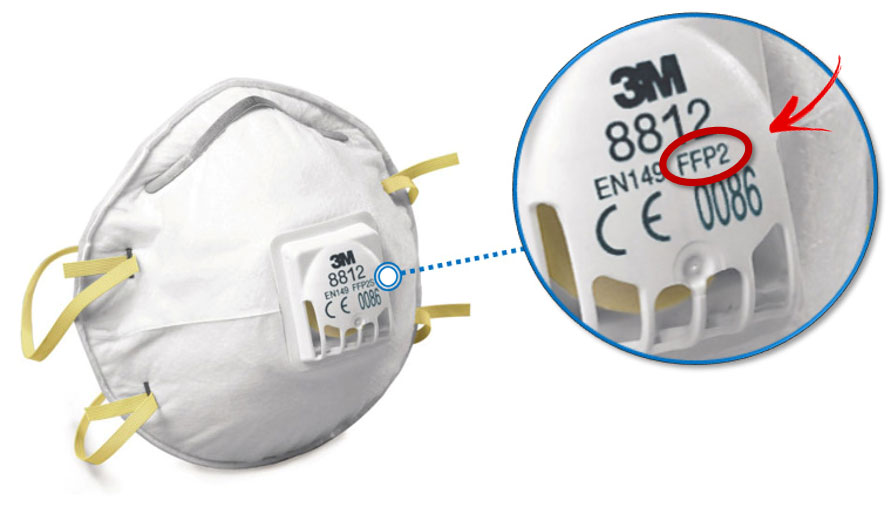
► Step 2: What do the additional letters on my dust mask mean?
Sometimes you will find these letters before or after the FFP class of your respirator.
| Additional designation | Meaning |
| D(durability test) | This durability test indicates that the filter is not clogged too quickly. Therefore, the mask can be used several times within the same working day. |
| R / NR (Reusable / Non-Reusable) | A mask marked “Reusable” has a sealing ring on the inside. This seal allows the mask to be cleaned and reused the next day. |
| V(valve) | A “valve” or exhalation valve reduces exhalation resistance and reduces CO2 content, humidity and temperature inside the mask. |
► Step 3: Flexible or rigid mask?
A rigid mask always retains its shape and is often a little cheaper to buy. A flexible mask, on the other hand, is more comfortable because it fits better on the face. You can also fold it more easily and keep it in your pocket.

► Step 4: Valved or valveless?
In a dust mask without a valve the filter gets saturated faster. Dust masks with an exhalation valve last longer. The valve works like this: It closes when you inhale and opens when you exhale. Therefore, CO2 can escape from the mask more easily, making the filter last longer
.The valve keeps the dust mask fresh and dry inside for longer. That is much more pleasant when worn for a long time. If you also wear safety glasses at the same time, they will fog up less because less humid air escapes.
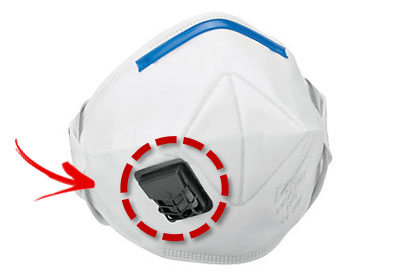
► don’t forget this!
- Flexible dust masks with the designation V (valve) are much more comfortable to wear.
- A dust mask only protects against dust, not against paint or fumes.
- are you taking a break? Then lower the mask from the open side (i.e. the side facing your face) downwards, so that no harmful dust can enter.
- when does a dust mask become saturated? A dust mask should be replaced when: Inhalation resistance increases or when ambient dust enters.
Advice on masks to avoid COVID19
From 21/05/2020 the use of dust masks in the street will be compulsory for people over 6 years old.
Link to BOE: https://boe.es/diario_boe/txt.php?id=BOE-A-2020-5142
As a prevention policy that will remain in place for the duration of the state of alert, it will be compulsory for people over 6 years of age to wear face masks on public roads or in open-air spaces and enclosed or open spaces for public use, when it is not possible to maintain an interpersonal distance of at least 2 metres and on public transport.
There are 2 types of masks: surgical masks and filtering face masks. The former prevent contagion to other people but do not prevent contagion, while filtering masks do, all types of filtering face masks are explained in this post.
If you need more information to protect your clients and employees, this post may interest you: Safety in times of coronavirus: Ensure social distance at work.
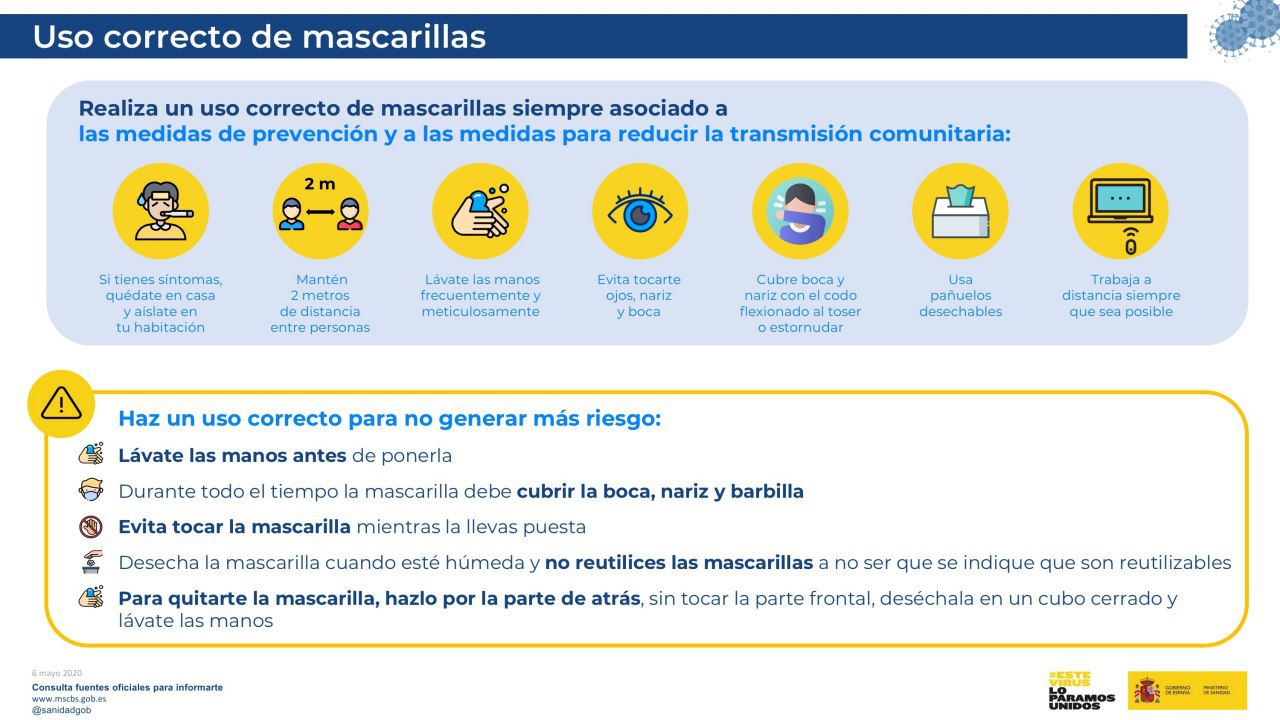
Before we move on to dust masks we would like to make an aside, in this article we will focus on FFP (Filtering Face Piece) filtering face masks for use in the work environment. Due to the current context of COVID-19, at the end of this post we will refer to the official indications regarding masks for protection, as well as other recommended preventive measures.
► Step 1: Choose a dust mask with the correct FFP class
The FFP code stands for Filtering Facepiece Particals. It indicates the way your dust mask filters the air. You can imagine the filter as a sieve full of holes, the smaller the holes, the smaller the particles that are filtered out. The disadvantage of a very good filter is that the holes through which you have to breathe are so small that you have to work much harder. We distinguish three levels of the FFP class, from low to high filter level:
FFP class |
Filter level |
Uses |
| FFP1 | ► Protect against harmless smoke/dust/fog. ► Filter capacity 78% E.g. Cotton or wood particles, graphite, ferrous metals, calcium carbonate, hay, etc. |
Construction sector, food industry. |
| FFP2 | ► Protects against irritating smoke/dust/mist. ► Filter capacity 92% E.g.: Residual metal particles, resin and glass wool, seeds and fungi, flour dust, etc. |
► Protects against smoke/dust/smog. ► Filter capacity: E.g.: Ceramic fibres, ceramic fibres, ceramic fibres, dust, etc 98% For example: Ceramic fibres, rock wool, cadmium, chromium, etc. |
| FFP3 | ► Protects against smoke/dust/smog. ► Filter Capacity 98% For example: Ceramic fibres, rock wool, cadmium, chrome, etc. |
Chemical sector, pharmaceutical industry, metallurgical industry, shipbuilding. |
ℹ Information: To protect against a virus (such as COVID-19), it is best to use FFP2 or FFP3 class face masks, without an exhalation valve.

► Step 2: What do the additional letters on my dust mask mean?
Sometimes you will find these letters before or after the FFP class of your respirator.
| Additional designation | Meaning |
| D(durability test) | This durability test indicates that the filter is not clogged too quickly. Therefore, the mask can be used several times within the same working day. |
| R / NR (Reusable / Non-Reusable) | A mask marked “Reusable” has a sealing ring on the inside. This seal allows the mask to be cleaned and reused the next day. |
| V(valve) | A “valve” or exhalation valve reduces exhalation resistance and reduces CO2 content, humidity and temperature inside the mask. |
► Step 3: Flexible or rigid mask?
A rigid mask always retains its shape and is often a little cheaper to buy. A flexible mask, on the other hand, is more comfortable because it fits better on the face. You can also fold it more easily and keep it in your pocket.

► Step 4: Valved or valveless?
In a dust mask without a valve the filter gets saturated faster. Dust masks with an exhalation valve last longer. The valve works like this: It closes when you inhale and opens when you exhale. Therefore, CO2 can escape from the mask more easily, making the filter last longer
.The valve keeps the dust mask fresh and dry inside for longer. That is much more pleasant when worn for a long time. If you also wear safety glasses at the same time, they will fog up less because less humid air escapes.

► don’t forget this!
- Flexible dust masks with the designation V (valve) are much more comfortable to wear.
- A dust mask only protects against dust, not against paint or fumes.
- are you taking a break? Then lower the mask from the open side (i.e. the side facing your face) downwards, so that no harmful dust can enter.
- when does a dust mask become saturated? A dust mask should be replaced when: Inhalation resistance increases or when ambient dust enters.
Advice on masks to avoid COVID19
From 21/05/2020 the use of dust masks in the street will be compulsory for people over 6 years old.
Link to BOE: https://boe.es/diario_boe/txt.php?id=BOE-A-2020-5142
As a prevention policy that will remain in place for the duration of the state of alert, it will be compulsory for people over 6 years of age to wear face masks on public roads or in open-air spaces and enclosed or open spaces for public use, when it is not possible to maintain an interpersonal distance of at least 2 metres and on public transport.
There are 2 types of masks: surgical masks and filtering face masks. The former prevent contagion to other people but do not prevent contagion, while filtering masks do, all types of filtering face masks are explained in this post.
If you need more information to protect your clients and employees, this post may interest you: Safety in times of coronavirus: Ensure social distance at work.

we inhale and exhale 20,000 times on average per day. That’s approximately 6,600 times during working hours. If you work in an environment with a lot of dust or dirt in the air, this can affect your respiratory tract and a dust mask is necessary. Dust masks protect against risks from airborne particles and are divided according to FFP class: this is an indicator of the filtering of the mask.
Learn how to choose the right dust mask for your needs in this post!
Before we move on to dust masks we would like to make an aside, in this article we will focus on FFP (Filtering Face Piece) filtering face masks for use in the work environment. Due to the current context of COVID-19, at the end of this post we will refer to the official indications regarding masks for protection, as well as other recommended preventive measures.
► Step 1: Choose a dust mask with the correct FFP class
The FFP code stands for Filtering Facepiece Particals. It indicates the way your dust mask filters the air. You can imagine the filter as a sieve full of holes, the smaller the holes, the smaller the particles that are filtered out. The disadvantage of a very good filter is that the holes through which you have to breathe are so small that you have to work much harder. We distinguish three levels of the FFP class, from low to high filter level:
FFP class |
Filter level |
Uses |
| FFP1 | ► Protect against harmless smoke/dust/fog. ► Filter capacity 78% E.g. Cotton or wood particles, graphite, ferrous metals, calcium carbonate, hay, etc. |
Construction sector, food industry. |
| FFP2 | ► Protects against irritating smoke/dust/mist. ► Filter capacity 92% E.g.: Residual metal particles, resin and glass wool, seeds and fungi, flour dust, etc. |
► Protects against smoke/dust/smog. ► Filter capacity: E.g.: Ceramic fibres, ceramic fibres, ceramic fibres, dust, etc 98% For example: Ceramic fibres, rock wool, cadmium, chromium, etc. |
| FFP3 | ► Protects against smoke/dust/smog. ► Filter Capacity 98% For example: Ceramic fibres, rock wool, cadmium, chrome, etc. |
Chemical sector, pharmaceutical industry, metallurgical industry, shipbuilding. |
ℹ Information: To protect against a virus (such as COVID-19), it is best to use FFP2 or FFP3 class face masks, without an exhalation valve.

► Step 2: What do the additional letters on my dust mask mean?
Sometimes you will find these letters before or after the FFP class of your respirator.
| Additional designation | Meaning |
| D(durability test) | This durability test indicates that the filter is not clogged too quickly. Therefore, the mask can be used several times within the same working day. |
| R / NR (Reusable / Non-Reusable) | A mask marked “Reusable” has a sealing ring on the inside. This seal allows the mask to be cleaned and reused the next day. |
| V(valve) | A “valve” or exhalation valve reduces exhalation resistance and reduces CO2 content, humidity and temperature inside the mask. |
► Step 3: Flexible or rigid mask?
A rigid mask always retains its shape and is often a little cheaper to buy. A flexible mask, on the other hand, is more comfortable because it fits better on the face. You can also fold it more easily and keep it in your pocket.

► Step 4: Valved or valveless?
In a dust mask without a valve the filter gets saturated faster. Dust masks with an exhalation valve last longer. The valve works like this: It closes when you inhale and opens when you exhale. Therefore, CO2 can escape from the mask more easily, making the filter last longer
.The valve keeps the dust mask fresh and dry inside for longer. That is much more pleasant when worn for a long time. If you also wear safety glasses at the same time, they will fog up less because less humid air escapes.

► don’t forget this!
- Flexible dust masks with the designation V (valve) are much more comfortable to wear.
- A dust mask only protects against dust, not against paint or fumes.
- are you taking a break? Then lower the mask from the open side (i.e. the side facing your face) downwards, so that no harmful dust can enter.
- when does a dust mask become saturated? A dust mask should be replaced when: Inhalation resistance increases or when ambient dust enters.
Advice on masks to avoid COVID19
From 21/05/2020 the use of dust masks in the street will be compulsory for people over 6 years old.
Link to BOE: https://boe.es/diario_boe/txt.php?id=BOE-A-2020-5142
As a prevention policy that will remain in place for the duration of the state of alert, it will be compulsory for people over 6 years of age to wear face masks on public roads or in open-air spaces and enclosed or open spaces for public use, when it is not possible to maintain an interpersonal distance of at least 2 metres and on public transport.
There are 2 types of masks: surgical masks and filtering face masks. The former prevent contagion to other people but do not prevent contagion, while filtering masks do, all types of filtering face masks are explained in this post.
If you need more information to protect your clients and employees, this post may interest you: Safety in times of coronavirus: Ensure social distance at work.













